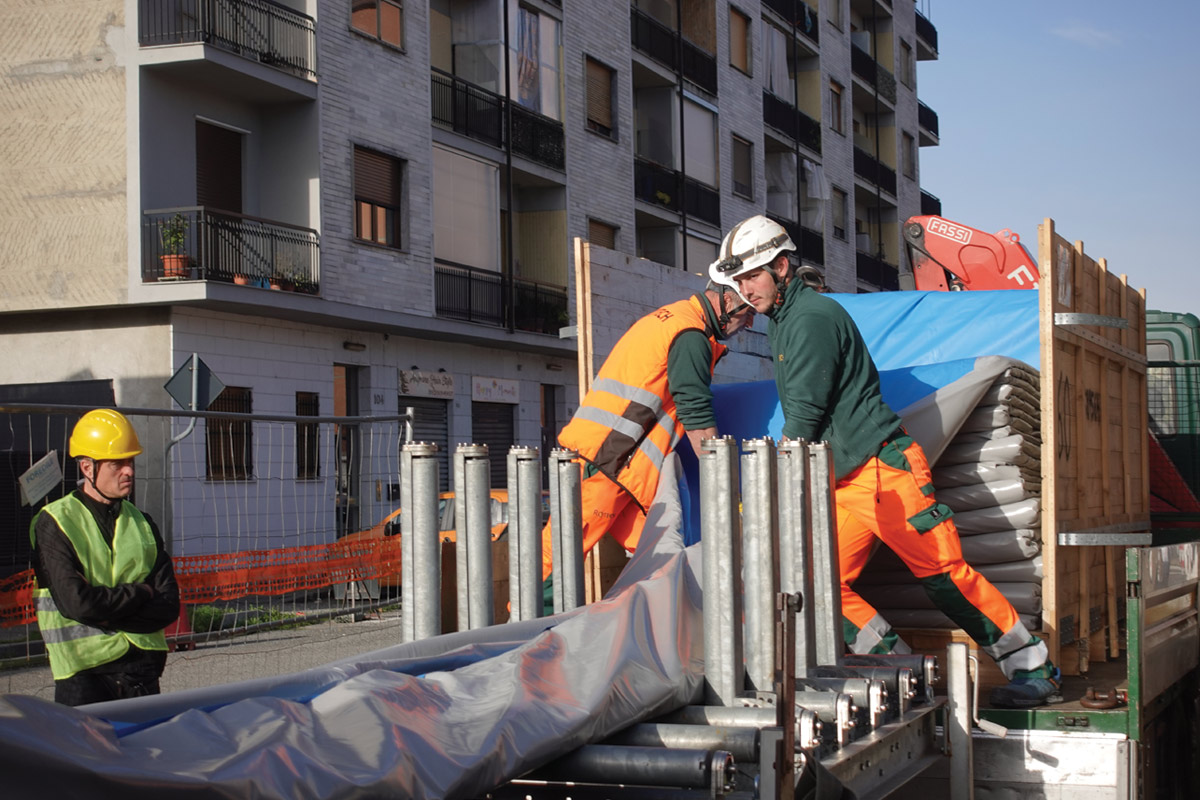Relining in Leipzig, Germany

The 90-year-old war monument, built to mark the 100th anniversary of thebattle, is currently undergoing rehabilitation to its down spouts, to correctleaking at various joints and offset joints. Because the pipes have been builtinto the monument’s walls, it is impossible to repair the damage externally andtrenchless rehabilitation, specifically relining, has proven to play a key rolein the fixing of the leaking down spouts.
This project presented several challenges for the contractor and liningmanufacturer, epros GmbH. Among the challenges were the horizontal and verticalbend radii and maintaining pressure to ensure the liner would adhere to thepipes.
The City of Leipzig is located in east central Germany, near the confluenceof the Pleisse, Parthe and Weisse Elster Rivers. Among the sites visitors takein is the Battle of Nations monument. The surrounding memorial covers some80,000 sq m and the viewing platform, which is at a height of 90 m, offering awonderful view over the town.
| Pipe Data |
• Material – DN 150 cast iron pipes • First gallery starting point – Storm water gully in the upper outerplatform at a height of 69.5 m • Second gallery to the top of the monument: Down spouts of 7 to 8 m inlength either consisting of two 45-degree bends or one 45-degree and one90-degree bend. • Top of monument: Down spouts of 20 m in length with various bends andconfigurations ending somewhere between the first gallery and groundlevel. |
The Project
The project was commissionedby the Battle of Nations Monument Foundation in cooperation with thegovernmental Building Control Authority for the renovation of the downpipes,which drain the rain water from the city’s Battle of Nations Monument. After twofailed attempts to complete the job successfully, the customer contacted eprosGmbH to see if it was possible that the Duisburg, Germany-based company couldreline a down spout of such a length.
Epros agreed to accept the challenge and Stefan Mühlin of epros GmbH went toLeipzig to first provide the installation crew with training and then to assistthe customer with the installation.The project has been divided into threephases, with the first section being to renovate the downpipes that originatefrom a storm water gully in the first gallery which was at a height of 69.5 m.The entire length of the down spouts were aproximately 50 m and there were eightidentical configurations to be lined. The second phase of the project was fromthe first viewing gallery to the second gallery and the final phase will be fromthe second gallery to the top of the monument.
The project was not however without its problems. Due to the age of themonument, the drawings of the drainage area were not precise enough to see theexact layout and configuration of the down spouts. A push camera was used toascertain the pipe conditions and the configuration of the joints, as well aswhere the drainage exits were. This also proved to be difficult and eprosresorted to pouring water down the pipes to see where they drained. Anotherproblem was to get the epros inversion drums onto the various galleries. Toovercome this, an outside lift was used to position the inversion drum on thefirst gallery, while an internal elevator was used to move the equipment andmaterials from the first gallery to the second gallery. The top of the monumentproved to be the most challenging of all. Luckily, epros could make use of aninternal crane that already existed for cleaning purposes and re-position allthe required equipment and material.
For the first phase of the project, a competitor material was used togetherwith the epros Inversion Drum Type II. The drum was fitted with a 4-m spiralhose and straight fitting attachments. For the second and third phase of theproject, an epros Type I inversion drum was used because it was lighter and morecompact than its Type II counterpart.
Because the pipes only had a single access point, a calibration hose was usedas there was no access from the bottom of the pipe. This method of lining iscalled Open End Lining, which means that the liner and the calibration hose areinverted simultaneously into the pipe. The epros Silicate Resin was chosen forthe down spouts from the top of the monument to the second gallery and for thoseending somewhere between the first gallery and ground level.The reason for thiswas that not only does it achieve good bonding strengths to cast iron pipes butit is cured ambiently. The resin has a high-chemical resistance, is odorless andhas low shrinkage. The higher viscosity version, L30E3, was chosen so that theDrainPlusLiner, with its flexibility, did not have resin loss on the bends.Thisensures that the resin was retained in the fibers of the liner. A resin with alow viscosity will drop, leaving places of the liner dry. Inversion of the linerinto the pipe was achieved by means of air, as inversion using water would causea problem as the weight on the verticals might cause the liner to split.
The project commenced in autumn 2004. It is important to note that duringinstallation there was a great variation in outside temperature and theinstallation crew often experienced windy conditions. The crew still managed toline three of the 7-to 8-m shorter runs per day. Due to budgetary constraints,the project is, however, not yet completed.
Key Points
It is important to note thatthere are a few key points when undertaking a project of this kind. First, a lotof experience is required to do this project and secondly, that in order tosuccessfully line pipes, the same pressure must be maintained all the time.Should the pressure drop for any reason, then the liner will no longer be heldagainst the pipe wall, causing sliding and stretching. If there is sliding onsections of the pipe where there are bends, then the pipe diameter will bereduced, which could cause blockages. If sliding occurs at the bottom of thepipe then the liner will bunch together again causing blockages in the lowersections of the pipe.




